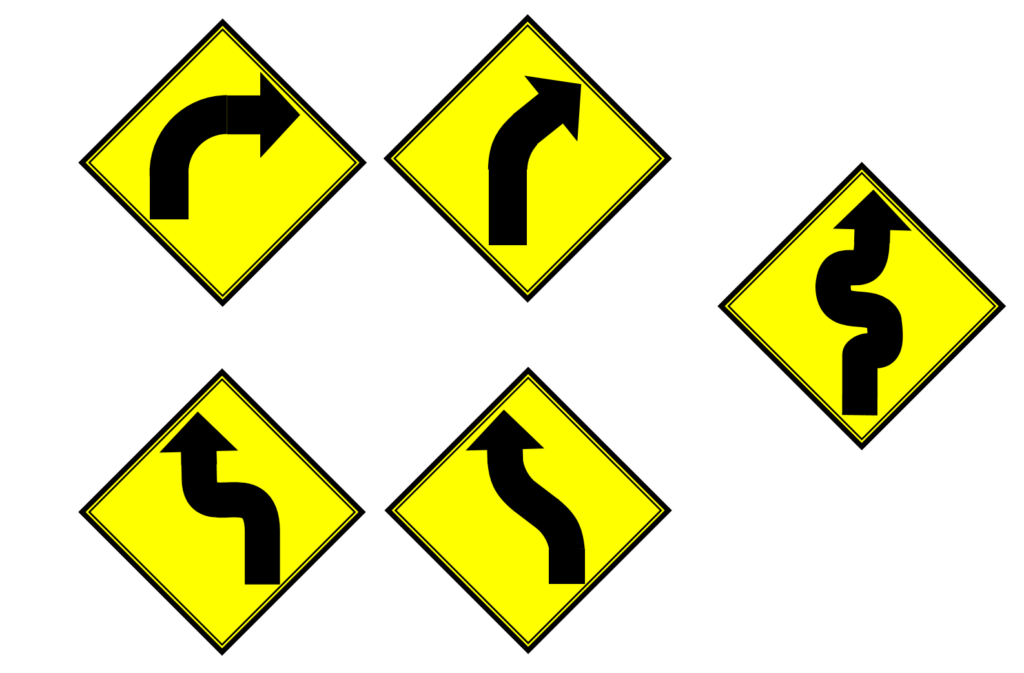
What are the differences between these signs?
By Paul Basha, traffic engineer, Summit Land Management
These are black-on-yellow signs – warning drivers of a permanent street condition or traffic situation that might not be obvious. If the signs are black-on-orange, then the nonobvious condition or situation is caused by construction.
The sign in the upper left is a “Turn” sign used for curves with a safe speed of 30 milesper-hour or less. The upper right is a “Curve” sign for curves with a safe speed of more than 30 miles-per-hour. If the safe speed is greater than the posted black-on-white speed limit, then no speed limit is provided beneath the sign. If the safe speed is lower than the posted black-on-white speed limit, then the safe speed is also posted on the sign.
The lower left sign is a “Reverse Turn” sign. This sign is for two curves – at least one with a safe speed of 30 mph or less – separated by less than 600 feet. The lower right sign is a “Reverse Curve” used for two curves – both safer than 30 mph – separated by less than 600 feet.
The far right sign is used for roadways with three or more curves separated by less than 600 feet, for all speeds.
If curves are separated by 600 feet or more, the separate curves have separate signs.

How are safe speeds on curves determined?
There are two distinctly different possibilities for the speeds. The most typical safe speed is based on the road curvature and superelevation (the sideways slant of the road). This determination is based on driver comfort. The concept is if drivers or passengers feel uncomfortable traveling around a curve, they might over-react and abruptly slow or over-steer, which may then cause a collision. Because this safe speed determination is comfort-based, different people have different definitions of comfortable. (Motorcyclists typically drive curves much faster than the advisory speed plate – as adventurous discomfort is often the primary motive for motorcycle-riding.) Also, a low vehicle or a vehicle with sophisticated suspension will be able to travel faster than these warning speeds without drivers or passengers feeling uncomfortable.
The second reason for the safe speed on a curve is because something such as a building or landscaping blocks driver visibility of the roadway. This physical obstruction means that a driver might be unable to see and stop before hitting an unexpected object in their travel lane, such as a slow-moving vehicle or something that has fallen off a vehicle or, in mountainous areas, large rocks or debris. In these situations, high-quality suspension is meaningless. And, a low vehicle has a lower safe speed then the sign states because the driver eye is lower. Motorcyclists need not worry, because quickly avoiding suddenly appearing objects is great fun.
Unfortunately, there is no distinction on the signs between these two rationales for lower safe speeds. Also, rarely is the source of the slower speed obvious – the reason the warning sign exists.
Can a police officer write a ticket for drivers exceeding these speeds in black-onyellow signs?
Yes, absolutely. Arizona state law specifically designates that drivers must drive at a prudent speed. Section 28-701.A states, “A person shall not drive a vehicle on a highway at a speed greater than is reasonable and prudent under the circumstances, conditions and actual and potential hazards then existing. A person shall control the speed of a vehicle as necessary to avoid colliding with any object, person, vehicle or other conveyance on, entering or adjacent to the highway in compliance with legal requirements and the duty of all persons to exercise reasonable care for the protection of others.” Exceeding the black-on-yellow speed is clear evidence of violating this law. However, police officers rarely write tickets for this reason … unless the speeding driver causes a collision, then a ticket properly identifies the driver responsible for the damage and injuries.
Curious about something traffic? Call or e-mail Paul at (480) 505-3931 and pbasha@summitlandmgmt.com.












